
Grevillea petrophiloides, commonly known as pink pokers, rock grevillea or poker grevillea, is a species of flowering plant in the family Proteaceae and is endemic to the south-west of Western Australia. It is an erect shrub with divided leaves, the lobes mostly linear, and cylindrical clusters of usually pink to reddish pink and bluish-grey flowers.

Grevillea vestita is species of flowering plant in the family Proteaceae and is endemic to the south-west of Western Australia. It is an erect, spreading, prickly shrub with lobed leaves, the number and arrangement of lobes depending on subspecies, and more or less spherical to dome-shaped clusters of hairy, white to cream-coloured flowers sometimes tinged with pink.
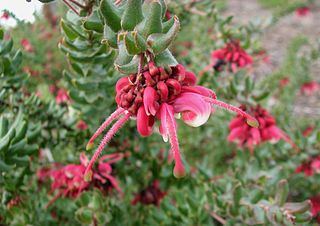
Grevillea baueri, commonly known as Bauer's grevillea, is a species of flowering plant in the family Proteaceae and is endemic to the coastal ranges of south-eastern New South Wales. It is a low, spreading to erect shrub with mostly oblong to egg-shaped leaves with red to pink and cream-coloured or yellow flowers.

Grevillea caleyi, also known as Caley's grevillea, is a species of flowering plant in the family Proteaceae and is endemic to a restricted area of New South Wales. It is an open, spreading shrub with deeply divided leaves with linear lobes, and fawn flowers with a maroon to red style.

Grevillea arenaria, commonly known as sand grevillea or hoary grevillea, is a species of flowering plant in the family Proteaceae and is endemic to New South Wales. It is a spreading shrub with elliptic to egg-shaped leaves with the narrower end towards the base, and red, pink or orange flowers.

Grevillea rhyolitica, commonly known as Deua grevillea or Deua flame, is a species of flowering plant in the family Proteaceae and is endemic to south-eastern New South Wales. It is a more or less erect shrub with elliptic leaves and hairy red flowers.
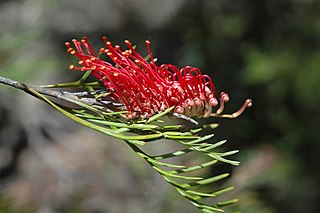
Grevillea hookeriana, commonly known as red toothbrushes or Hooker's grevillea, is a species of flowering plant in the family Proteaceae and is endemic to the south-west of Western Australia. It is a spreading to erect shrub, usually with linear leaves or deeply divided leaves with linear lobes, and toothbrush-shaped groups of red, black or yellowish green flowers, the style maroon to black.

Grevillea agrifolia, the blue grevillea, is a species of flowering plant in the family Proteaceae and is native to the north of Western Australia and parts of the Northern Territory. It is a shrub or tree with narrowly oblong leaves with the narrower end towards the base, and creamy-yellow flowers.
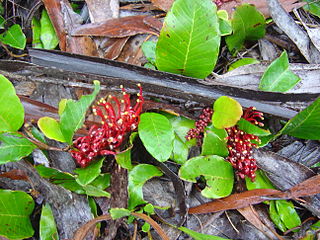
Grevillea laurifolia, commonly known as laurel-leaf grevillea, is a species of flowering plant in the family Proteaceae and is endemic to New South Wales. It is a prostrate, trailing shrub with egg-shaped, heart-shaped or round leaves, and clusters of reddish to deep maroon flowers.
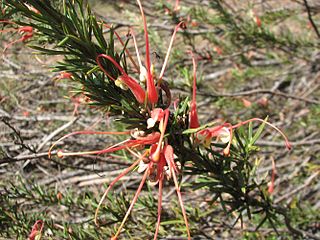
Grevillea tripartita is species of flowering plant in the family Proteaceae and is endemic to the south-west of Western Australia. It is an erect, prickly shrub with divided leaves with 3 lobes, and clusters of red and cream-coloured or reddish-orange and yellow flowers.
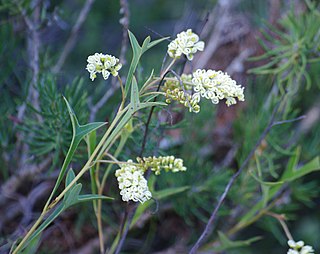
Grevillea synapheae, commonly known as catkin grevillea, is species of flowering plant in the family Proteaceae and is endemic to the southwest of Western Australia. It is a prostrate to erect shrub usually with divided leaves with 3 to 7 triangular to more or less linear lobes, and clusters of white to creamy yellow flowers.

Grevillea irrasa is a species of flowering plant in the family Proteaceae and is endemic to south-eastern New South Wales. It is an erect, spreading shrub with oblong to egg-shaped leaves with the narrower end towards the base, and clusters of red to apricot-coloured flowers.

Grevillea ilicifolia, commonly known as holly grevillea or holly bush, is a species of flowering plant in the family Proteaceae and is endemic to southern continental Australia. It is a spreading to prostrate shrub with holly-like leaves with sharply-pointed triangular to egg-shaped teeth or lobes, and clusters of green to cream-coloured and mauve flowers with a pink to red style.
Grevillea parviflora, commonly known as small-flower grevillea, is a species of flowering plant in the family Proteaceae and is endemic to the Sydney region of eastern New South Wales. It is a low, dense, spreading to erect shrub with more or less linear leaves and white flowers with a red style that sometimes turns red as it ages.

Grevillea floribunda, commonly known as seven dwarfs grevillea, is a species of flowering plant in the family Proteaceae and is endemic to eastern Australia. It is a spreading shrub with oblong to egg-shaped leaves with the narrower end towards the base and groups of six to twenty flowers covered with rusty brown hairs.
Grevillea obtusiflora is a species of flowering plant in the family Proteaceae and is endemic to a small area of eastern New South Wales. It is a low, spreading to erect shrub with many stems, narrowly elliptic to oblong or linear to narrowly egg-shaped leaves with the narrower end towards the base, and pinkish-red and cream-coloured flowers with a red style.
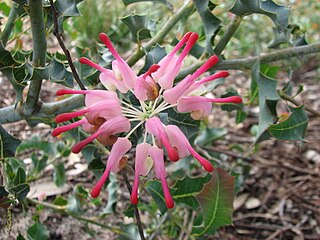
Grevillea insignis, commonly known as wax grevillea, is a species of flowering plant in the family Proteaceae and is endemic to the south-west of Western Australia. It is an erect, bushy shrub with more or less oblong leaves with seven to seventeen sharply-pointed, triangular teeth, and more or less spherical or cylindrical clusters of cream-coloured flowers ageing to pink.

Grevillea coccinea is a species of flowering plant in the family Proteaceae and is endemic to the south of Western Australia. It is a low-lying or sprawling shrub with narrowly wedge-shaped to linear leaves and white, cream-coloured, and red or yellow flowers.

Grevillea manglesioides is a species of flowering plant in the family Proteaceae and is endemic to the south-west of Western Australia. It is a spreading shrub usually with wedge-shaped leaves with lobed ends, and toothbrush-shaped clusters of flowers, the colour varying with subspecies.

Grevillea pyramidalis, commonly known as the caustic bush, is a species of flowering plant in the family Proteaceae and is endemic to north-western Australia. It is an erect, spindly shrub or small tree with simple linear or pinnatisect leaves with linear to narrowly egg-shaped lobes, and white to yellow or cream-coloured flowers.





















